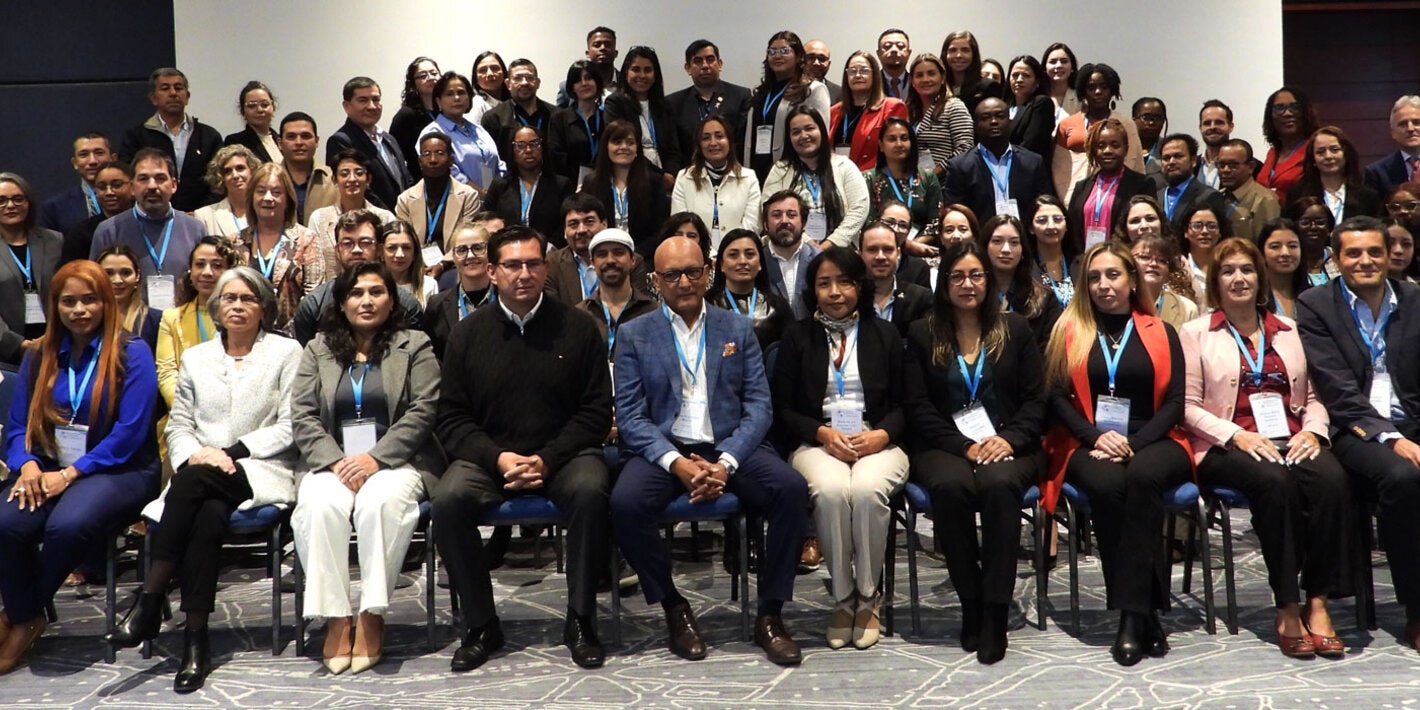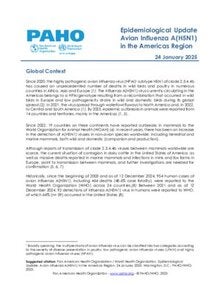Epidemiological alerts and updates
Avian influenza, also known as 'bird flu', is a disease primarily affecting birds and is caused by a virus of the Orthomyxoviridae family.
According to its subtype, it may be classified as high or low pathogenicity, presenting different symptoms in infected birds. The Low Pathogenic Avian Influenza Virus (LPAIV) can cause a mild illness, often unnoticed or without any symptoms. The Highly Pathogenic Avian Influenza Virus (HPAIV) caused by subtypes (H5 and H7) of type A, causes serious illness in birds that can spread rapidly, resulting in high death rates in different species of birds.
Most of the influenza viruses circulating in birds are not zoonotic. However, some HPAI strains have the ability to infect humans, posing a threat to public health. The main risk factor is the direct or indirect exposure to infected animals or environments and surfaces contaminated by feces.
Transmission
The most common way for the virus to enter a territory is through migratory wild birds. The main risk factor for transmission from birds to humans is direct or indirect contact with infected animals or with environments and surfaces contaminated by feces. Plucking, handling infected poultry carcasses, and preparing poultry for consumption, especially in domestic settings, may also be risk factors.
Symptoms
When avian influenza is transmitted to humans, symptoms in people can range from mild upper respiratory tract infection (fever and cough) to severe pneumonia, acute respiratory distress syndrome (difficulty breathing), shock, and even death.
Treatment
WHO has updated its clinical guidelines for influenza, including H5N1. Antiviral medicines are recommended for those with severe diseases or at risk of developing severe illness due to underlying conditions (e.g., older adults or individuals with chronic health issues). Oseltamivir is suggested for severe illness, while baloxavir is for those at risk. WHO also provides detailed recommendations for zoonotic influenza in its updated guidelines.
Vaccines
The World Health Organization (WHO) updates “candidate vaccine viruses” as part of pandemic preparedness to enable quick vaccine production if necessary. For the H5N1 virus detected in dairy cows, candidate vaccine viruses are available from WHO’s Global Influenza Surveillance and Response System (GISRS).
The emergence of pathogenic infectious diseases in the past twenty years and recent outbreaks of zoonotic diseases have increasingly drawn public attention to the fact that diseases move back and forth among species. Of the 1,415 known human pathogens, 61% are zoonotic. Among other things, it is estimated that the increase of emerging and reemerging livestock disease outbreaks around the world since the mid-1990s has cost the world $80 billion. A major factor in the emergence of new zoonoses is the closer contact with wildlife of both humans and their domesticated animals, caused in particular by increasing encroachment into wildlife habitats. Other general factors include environmental changes, globalization of food production and trade, microbiological adaptation, and human behavioral factors.
The globalization of travel and trade and faster exchanges of people and products between countries allow for rapid dissemination of infectious diseases from their initial focus. It is difficult to estimate the burden of zoonoses on human health, particularly because endemic infections are largely under-reported around the world. It is undeniable, however, that emerging zoonoses have both direct (in terms of morbidity and mortality) and indirect (in terms of their impact on public health practice and structure) implications on public health.
PAHO works with countries in the region and other agencies to strengthen avian influenza virus surveillance in animals and humans, and provides technical assistance for the timely detection, treatment and investigation of avian influenza A(H5N1) virus infection in humans. The organization also works to strengthen laboratory capacity in national veterinary and public health services so that they have the diagnostic capability to identify the presence of the avian influenza virus and detect changes in its genetic makeup.
CIPCIZA
In 2024, PAHO call to action for the establishment the Intersectoral Commission for the Prevention and Control of Zoonotic Influenza in the Americas (CIPCIZA, for its initials in Spanish) and A high-level consultation of experts was convened in Washington, D.C., to address gaps and opportunities related to the management of influenza at the human-animal interface. This expert meeting brought together representatives from public health, veterinary sciences, agriculture, and the environment across the Americas, highlighting PAHO’s commitment to a One Health approach to zoonotic diseases.
Recent Outbreak
Between 2022 and as of epidemiological week 52 of 2024, a total of 19 countries and territories in the Americas Region reported 4,388 animal outbreaks of H5N1 avian influenza. In 2025, human infections caused by avian influenza A(H5) have been reported in countries in the Americas. In response, PAHO has launched an interactive dashboard to monitor avian influenza A(H5N1) cases in the Americas. This tool is designed to improve access to data on outbreaks of this disease in birds, mammals, and humans, providing key information for public and animal health authorities. In December 2024, PAHO published an assessment of the public health risks associated with the potential occurrence of zoonotic avian influenza A(H5N1) in Latin America and the Caribbean, classifying the risk as moderate. To date, human-to-human transmission has not been identified. PAHO has also published a timeline on avian influenza in the Americas, covering key events from 2020 to December 2024.

















